Abstract
Establishment of a near-linear temperature gradient in an incubator has been accomplished by the application of heat to one terminus of a conducting body, normally a metal bar, and the removal of heat from the other terminus of the conducting body. Such incubators have been complex and unwieldy because of the need for mechanical refrigeration. We have described a simplified temperature gradient incubator which uses thermoelectric module cooling coupled with electric heating. Along the gradient, 20 stations in two parallel rows of 10, each accommodating a 30-ml plastic cell culture flask, were continually monitored by an electronic thermometer, and the temperatures were recorded. By manipulation of two simple potentiometer controls, any temperature gradient between 0 and 50 C could be obtained. Minor deviations which occurred between theoretically perfect and obtained temperature gradients were reproducible and readily measured. The gradient incubator was particularly applicable to (i) simultaneously studying a given biological activity over the entire temperature range supporting the growth of a given cell, virus, or microorganism, or (ii) precisely defining the upper or lower temperature limits of a biological system by 10-point determinations. Preliminary experiments have demonstrated the usefulness of the apparatus in characterizing the temperature limits for growth in vitro of cells of reptilian cell lines. The gradient incubator was also successfully utilized for the characterization of the effect of temperature on the efficiency of plating of amphibian viruses and possible temperature variants of those viruses.
Full text
PDF
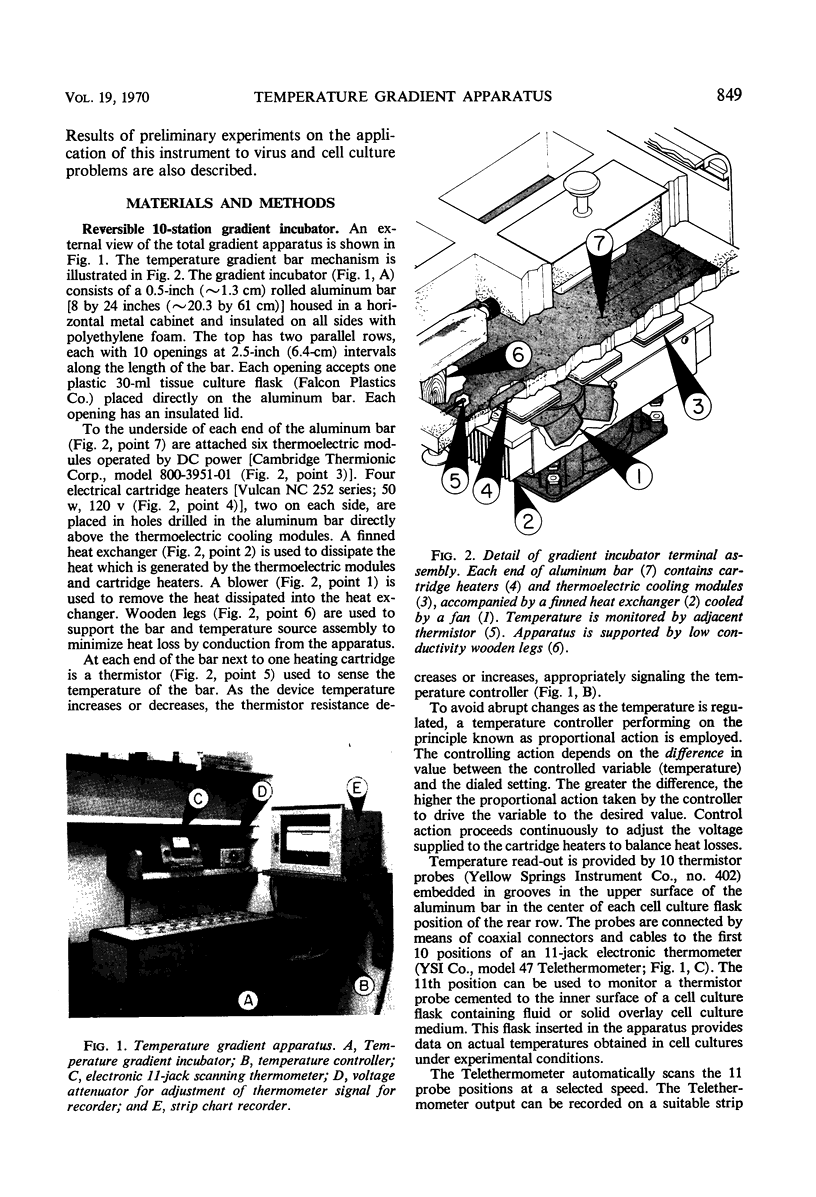
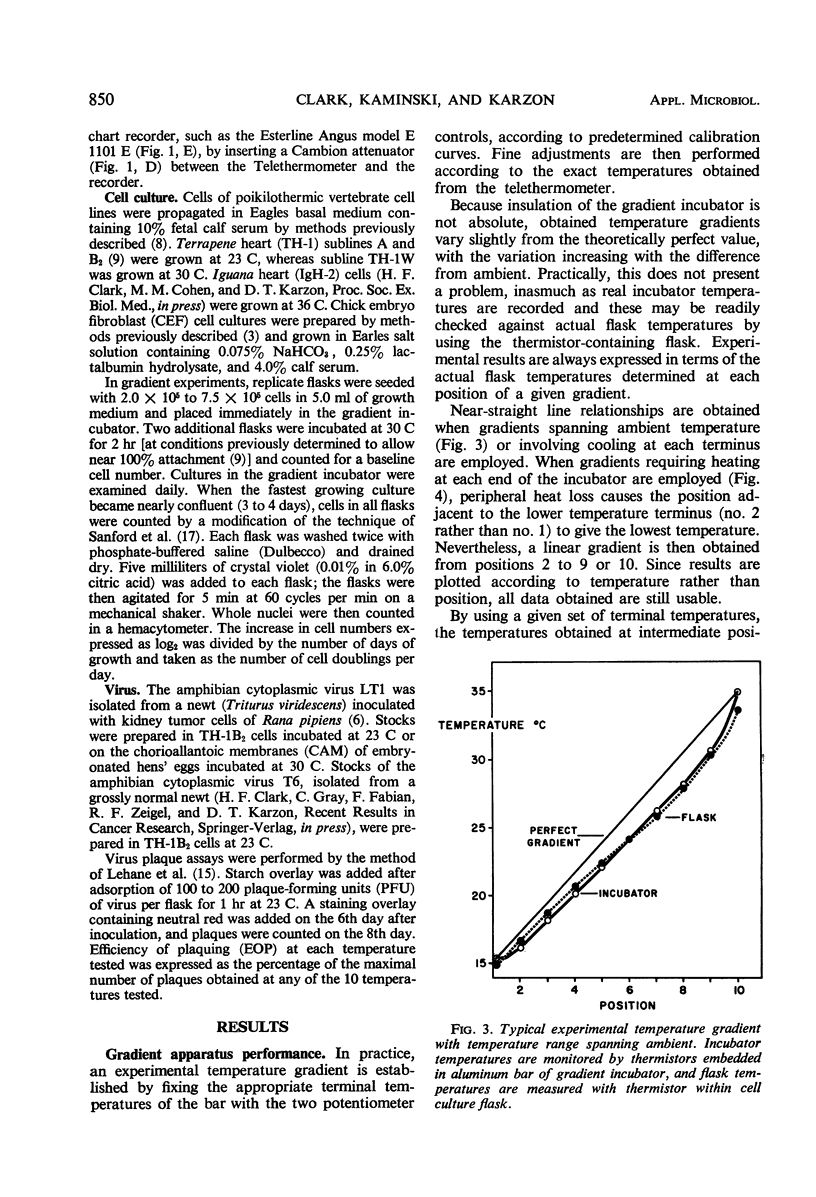
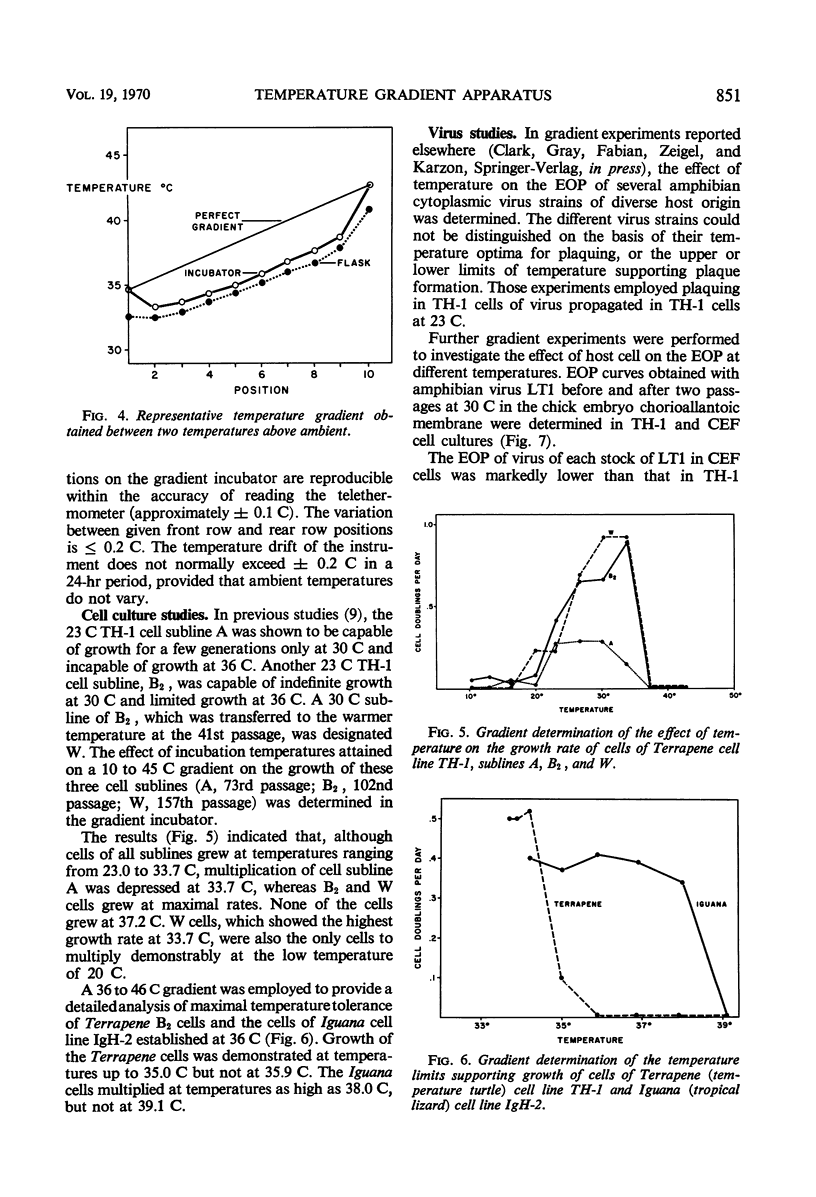
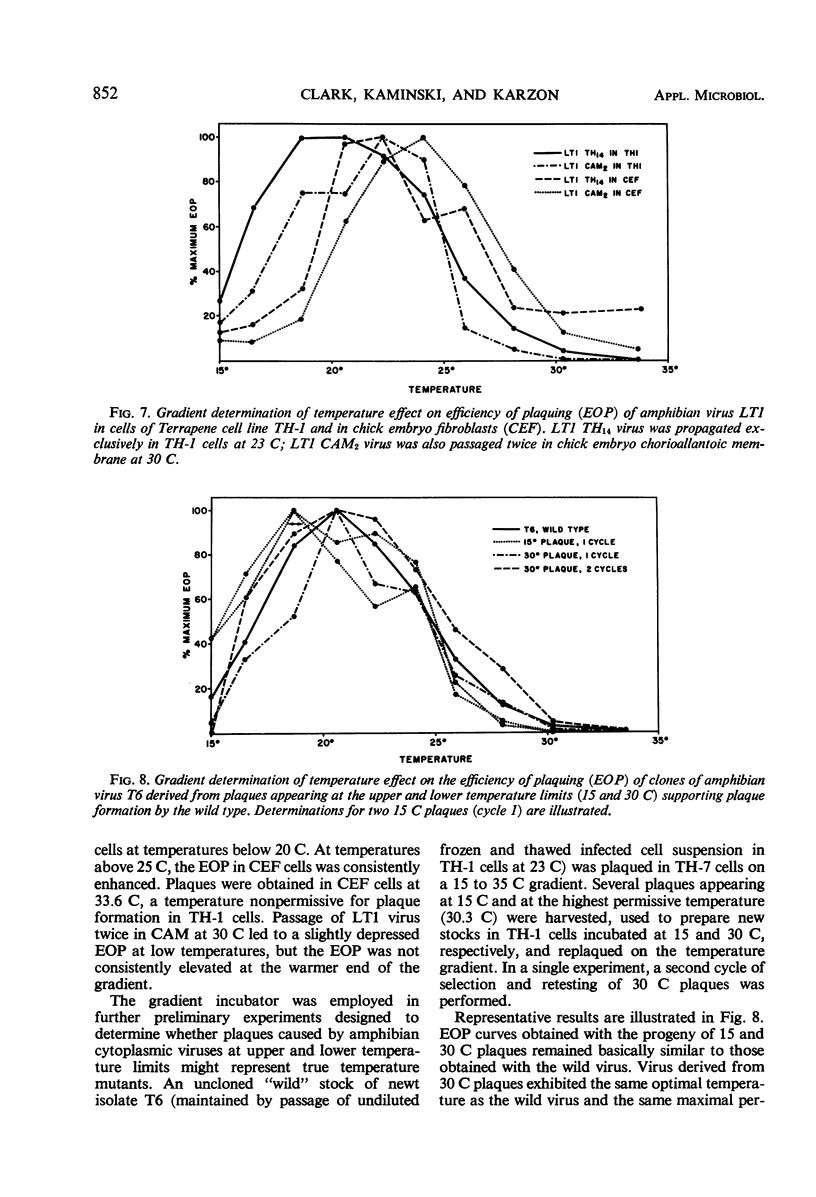
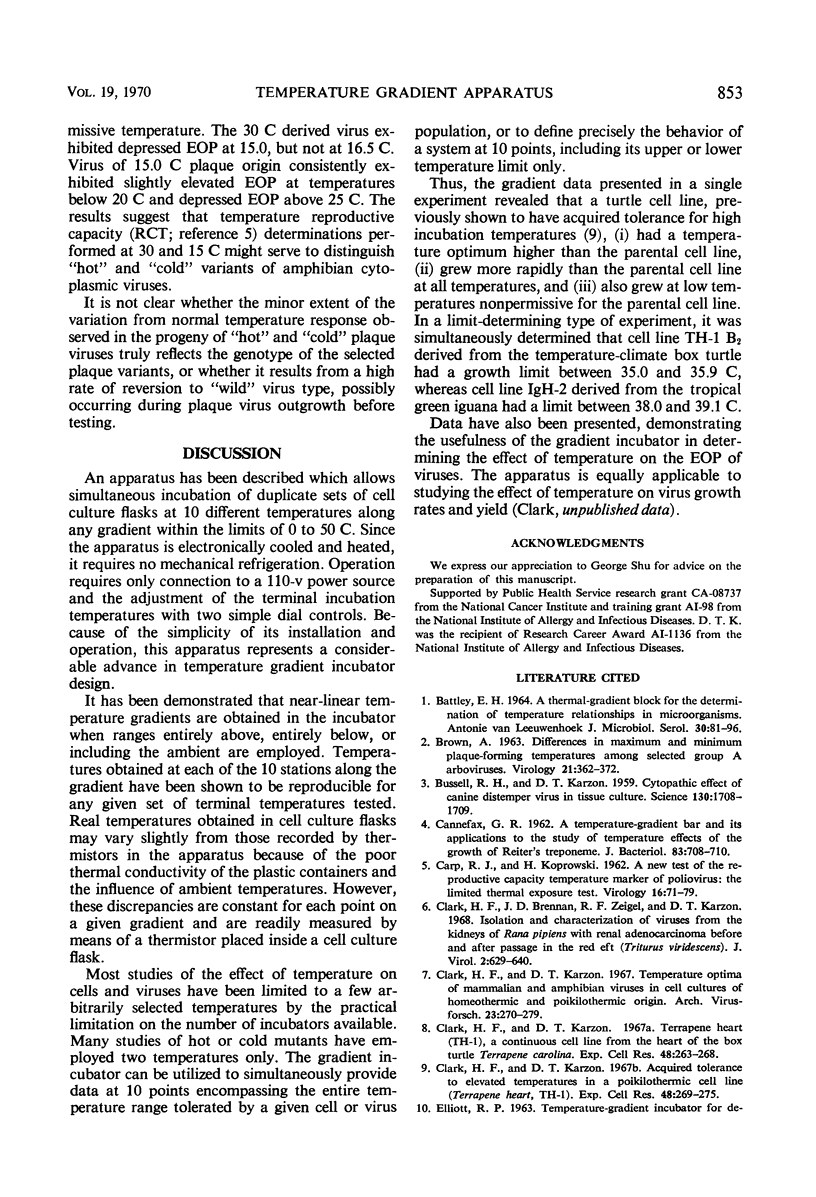

Images in this article
Selected References
These references are in PubMed. This may not be the complete list of references from this article.
- BATTLEY E. H. A THERMAL-GRADIENT BLOCK FOR THE DETERMINATION OF TEMPERATURE RELATIONSHIPS IN MICROORGANISMS. Antonie Van Leeuwenhoek. 1964;30:81–96. doi: 10.1007/BF02046706. [DOI] [PubMed] [Google Scholar]
- BROWN A. DIFFERENCES IN MAXIMUM AND MINIMUM PLAQUE-FORMING TEMPERATURES AMONG SELECTED GROUP A ARBORVIRUSES. Virology. 1963 Nov;21:362–372. doi: 10.1016/0042-6822(63)90197-1. [DOI] [PubMed] [Google Scholar]
- CANNEFAX G. R. A temperature-gradient bar and its applications to the study of temperature effects on the growth of Reiter's treponeme. J Bacteriol. 1962 Apr;83:708–710. doi: 10.1128/jb.83.4.708-710.1962. [DOI] [PMC free article] [PubMed] [Google Scholar]
- CARP R. I., KOPROWSKI H. A new test of the reproductive capacity temperature marker of poliovirus: the limited thermal exposure test. Virology. 1962 Jan;16:71–79. doi: 10.1016/0042-6822(62)90203-9. [DOI] [PubMed] [Google Scholar]
- Clark H. F., Brennan J. C., Zeigel R. F., Karzon D. T. Isolation and characterization of viruses from the kidneys of Rana pipiens with renal adenocarcinoma before and after passage in the red eft (Triturus viridescens). J Virol. 1968 Jun;2(6):629–640. doi: 10.1128/jvi.2.6.629-640.1968. [DOI] [PMC free article] [PubMed] [Google Scholar]
- Clark H. F., Karzon D. T. Acquired tolerance to elevated temperatures in a poikilothermic cell line (terrapene heart, TH-1). Exp Cell Res. 1967 Nov;48(2):269–275. doi: 10.1016/0014-4827(67)90352-7. [DOI] [PubMed] [Google Scholar]
- Clark H. F., Karzon D. T. Temperature optima of mammalian and amphibian viruses in cell cultures of homeothermic and poikilothermic origin. Arch Gesamte Virusforsch. 1968;23(3):270–279. doi: 10.1007/BF01241899. [DOI] [PubMed] [Google Scholar]
- Clark H. F., Karzon D. T. Terrapene heart (TH-1), a continuous cell line from the heart of the box turtle Terrapene carolina. Exp Cell Res. 1967 Nov;48(2):263–268. doi: 10.1016/0014-4827(67)90351-5. [DOI] [PubMed] [Google Scholar]
- ELLIOTT R. P., HEINIGER P. K. IMPROVED TEMPERATURE-GRADIENT INCUBATOR AND THE MAXIMAL GROWTH TEMPERATURE AND HEAT RESISTANCE OF SALMONELLA. Appl Microbiol. 1965 Jan;13:73–76. doi: 10.1128/am.13.1.73-76.1965. [DOI] [PMC free article] [PubMed] [Google Scholar]
- ELLIOTT R. P. TEMPERATURE-GRADIENT INCUBATOR FOR DETERMINING THE TEMPERATURE RANGE OF GROWTH OF MICROORGANISMS. J Bacteriol. 1963 Apr;85:889–894. doi: 10.1128/jb.85.4.889-894.1963. [DOI] [PMC free article] [PubMed] [Google Scholar]
- KARZON D. T., BUSSELL R. H. Cytopathic effect of canine distemper virus in tissue culture. Science. 1959 Dec 18;130(3390):1708–1709. doi: 10.1126/science.130.3390.1708. [DOI] [PubMed] [Google Scholar]
- LANDMAN O. E., BAUSUM H. T., MATNEY T. S. Temperaturegradient plates for growth of microorganisms. J Bacteriol. 1962 Mar;83:463–469. doi: 10.1128/jb.83.3.463-469.1962. [DOI] [PMC free article] [PubMed] [Google Scholar]
- LWOFF A. Factors influencing the evolution of viral diseases at the cellular level and in the organism. Bacteriol Rev. 1959 Sep;23(3):109–124. doi: 10.1128/br.23.3.109-124.1959. [DOI] [PMC free article] [PubMed] [Google Scholar]
- Lehane D. E., Jr, Clark H. F., Karzon D. T. A plaque method for titration of frog viruses using starch gel overlay. Proc Soc Exp Biol Med. 1967 May;125(1):50–54. doi: 10.3181/00379727-125-32010. [DOI] [PubMed] [Google Scholar]
- SANFORD K. K., EARLE W. R., EVANS V. J., WALTZ H. K., SHANNON J. E. The measurement of proliferation in tissue cultures by enumeration of cell nuclei. J Natl Cancer Inst. 1951 Feb;11(4):773–795. [PubMed] [Google Scholar]



